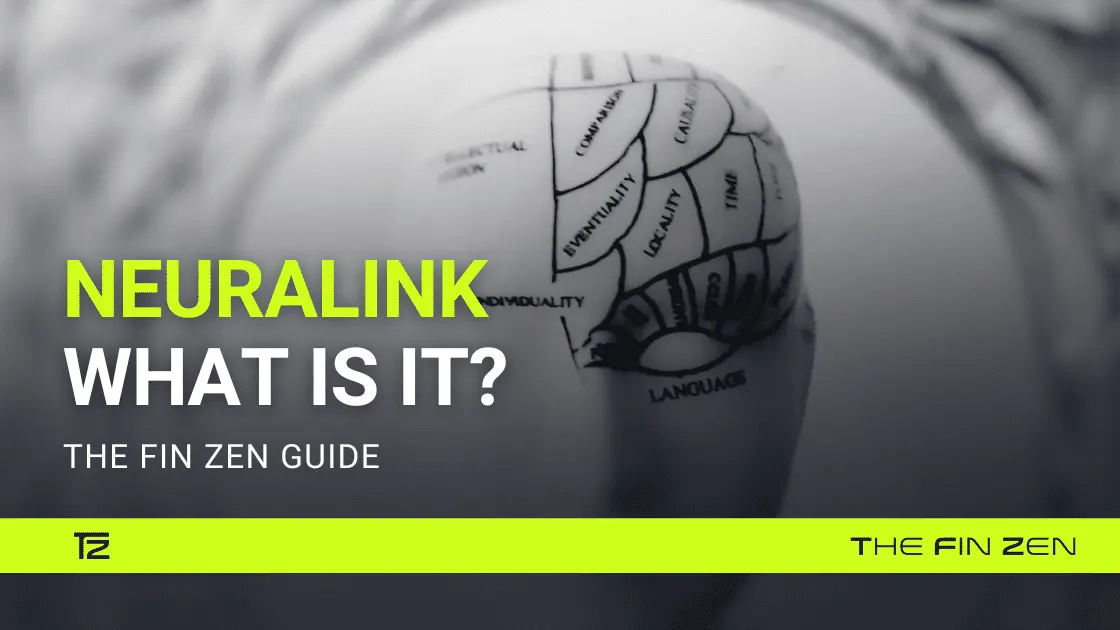With the rapid progress of neurotechnology and the emergence of revolutionary brain-computer interfaces, such as those proposed by Neuralink, the company founded by Elon Musk, the line between human biology and digital technology is becoming increasingly blurred. These advances raise fundamental questions about the nature of human identity, the potential of the mind, and the ethical implications of ever-deepening interaction between man and machine. In this The Fin Zen article, we will dive into the intricacies of this ambitious project to determine whether Neuralink represents a milestone towards human progress or an expensive illusion fueled by Musk’s futuristic rhetoric.
Neuralink: Science fiction or Reality?
In the contemporary technological landscape, few names resonate with the same power and ambition as Elon Musk. Founder of revolutionary companies like SpaceX and Tesla, Musk has captivated the public’s imagination with his bold vision for the future of humanity. However, behind Musk’s brilliant promises lie fundamental questions and crucial doubts. Among Musk’s most ambitious and, at the same time, controversial projects is Neuralink. This company that promises to merge humanity with technology by directly interfacing the brain with computers. The device uses thin electrode wires to enhance cognitive abilities, offering new perspectives in treating neurodegenerative diseases and motor disabilities. The case study conducted on the pig Gertrude in 2020 demonstrated Neuralink’s ability to read and interpret neural signals, paving the way for an intriguing yet complex future.
What is Neuralink?
Neuralink is a Class III medical device, a high-risk device that is very important to health or sustaining life. It is known as a brain-computer interface (BCI). Bluetooth connects the brain to an external computer, allowing continuous two-way communication. The device itself is a coin-sized unit called the Link. It is implanted inside a small disk cut into the skull using a precision surgical robot. The robot connects a thousand tiny wires from the Link to specific neurons in the brain. Each wire is about a quarter of the diameter of a human hair. But while this vision evokes suggestive images of a sci-fi future, we cannot ignore the ethical, scientific, and social implications accompanying such a radical idea.
Neuralink’s Mission and Future Prospects
Their mission is to “create a general-purpose brain interface to restore autonomy to those with unmet medical needs today and unlock human potential tomorrow.” In the short term, the focus will be on people with medical needs. The long-term vision goes much further, alluding to enhancing human potential. This suggests that Neuralink envisions a future where its technology goes beyond medical use and becomes a cognitive and sensory enhancement tool in the general population. In January 2024, Neuralink made headlines by announcing the successful implantation of its first brain chip in a human subject, prompting scholars to examine the ethical dimensions of this innovative technology. The brain-computer interface device, known as N1, is designed to allow individuals to perform actions simply by focusing their thoughts without needing physical movement. In the PRIME study, participants undergo surgical implantation of the device into the brain region responsible for controlling movement. The chip captures and processes the brain’s electrical signals, transmitting this data to an external device, such as a smartphone or computer. The external device deciphers the user’s neural activity through sophisticated algorithms, learning to associate specific patterns with desired actions like moving a cursor on a screen or controlling a wheelchair. From correcting physical disabilities to improving cognitive abilities, the applications seem endless.
Possible Scenarios for Neuralink
Despite the ethical challenges and concerns raised, brain-computer interface technology could have the potential to significantly improve the lives of people with disabilities by offering greater possibilities for communication and mobility. Only through a balanced and conscious approach to ethical issues is it possible to maximize the benefits of such innovations without compromising the fundamental values of society and the well-being of individuals.
In the most realistic scenario, Neuralink is expected to succeed by focusing on medical applications for individuals with severe disabilities. This targeted approach will likely gain acceptance from consumers who need life-changing technologies, thus promoting early adoption within this demographic. In this case, broader acceptance among a wider consumer base will depend on various factors, including the perceived usefulness of the technology, privacy implications, and overall perceived risk-benefit ratio. From a societal perspective, Neuralink’s trajectory will be significantly influenced by public and ethical discussions. The broad acceptance of this technology will depend on its medical efficacy and safety, along with the ability to address moral concerns and gain public trust. In the optimistic scenario, consumer interest would extend beyond those with medical needs, driven by the allure of enhanced cognitive abilities and sensory experiences.
From a technological perspective, the complexity of directly interfacing with the human brain could be more challenging than expected, leading to disappointing performance or reliability issues. Concerns about physical and psychological safety may be more significant than initially thought, with potential long-term health implications that could deter consumers and medical professionals. The invasiveness of the technology and concerns about the privacy of brain data could lead to widespread public mistrust. This skepticism could be amplified if early technology applications were perceived as beneficial to only a few, exacerbating inequalities.
The Long Road to Approval for Human Studies
In February 2021, Musk said Neuralink was working with the FDA to get permission to start the first human trials later this year. However, human studies did not begin in 2021. Then, in March 2022, Neuralink submitted another application to the FDA to establish its readiness to begin human studies. The approval came on May 25, 2023, after the U.S. Office of the Inspector General launched an investigation into Neuralink for possible animal welfare violations.
What were the FDA’s concerns?
The FDA had a long list of issues to resolve before it could begin human trials, as reported by an investigation that claimed to have spoken to several Neuralink sources. Most of the concerns required Neuralink to conduct extensive and repeated testing and collect data over a prolonged period. This was likely a critical factor in why the approval process to start human studies was so long. It cannot be said with certainty that all problems have been entirely resolved. Amid the excitement over Neuralink’s potential, it’s essential to reflect on the FDA’s past mistakes in approving products that were later found unsafe. History records numerous cases in which rushed approval has negatively affected consumers’ health. These errors require critical reflection on regulatory practices and ensuring safety above all. Fair access, cybersecurity, and the potential for abuse of neural information are just some challenges that must be addressed. Furthermore, the inevitable evolution of this technology may introduce new ethical dilemmas that require careful and responsible consideration.
Possible Implications
The moral implications of Neuralink studies go beyond issues of transparency. While the lack of transparency regarding clinical trials raises questions about compliance with ethical standards and the protection of participants, private companies with profit motives could influence decisions regarding the safety and effectiveness of devices beyond the common good. The ethical implications also extend to how such devices affect patients’ privacy and autonomy. Access to thoughts and neural data raises concerns about information security and the risk of abuse by third parties. Furthermore, the introduction of permanently implanted devices raises questions about the reversibility of the procedures and the potential long-term consequences for patients. The journey is filled with challenges, including competition, ethical concerns, and patients’ long-term well-being. If Neuralink’s BCI can be made safe in humans, potential benefits would make the feat noteworthy. The company says the device could enable precise control of prosthetic limbs, providing natural motor skills to amputees. It could revolutionize the treatment of conditions such as Parkinson’s disease, epilepsy, and spinal cord injuries. It also shows some promise for the potential treatment of obesity, autism, depression, schizophrenia, and tinnitus.
Overheating lithium-ion batteries could pose a significant risk to BCI users. When faulty, such batteries have historically been known to overheat. They can even explode if the insulation between the cathode and anode (the metal electrode components) deteriorates, causing a short circuit. The battery’s longevity was also considered, as was how easy it would be to safely replace it from its location under the skin behind the ear. The Link is made of a disc-shaped chip with fragile wire electrodes that connect to neurons in the brain. Connecting these wires using a surgical robot is a significant challenge. But there’s also the possibility that the electrodes could move elsewhere in the brain over time due to natural movement, inflammation, or the formation of scar tissue. This would likely affect the proper functioning of the device and could cause infection or damage to brain tissue.
An Important Stage among the Challenges
Elon Musk’s Neuralink recently made headlines by announcing success in implanting its device into a human subject, marking a significant milestone for the company. On February 20, 2024, the first human patient to be injected with a Neuralink brain chip appeared to have fully recovered and could control a computer mouse using thought. The video of the patient, who seems to be able to play chess with his mind thanks to the implant, was published on the Neuralink YouTube page. Musk said Neuralink is focusing on maximizing the number of mouse button clicks patients can get.
Is Neuralink the Technological Future?
Neuralink represents a remarkable breakthrough in neurotechnology, but its path is fraught with ethical questions, safety concerns, and uncertainties about the future. The challenge is to find a balance between innovation and responsibility, ensuring that this advanced technology brings benefits without compromising the safety and integrity of the human mind.
Critics recognize Neuralink’s potential benefits but warn the company to proceed cautiously. Adequately addressing these issues will take time and, shortcuts cannot be taken to find a solution. In addition to the Link’s potential medical uses, Musk has made many sweeping statements regarding his future vision for the technology. He said Neuralink could augment human intelligence by creating an on-demand connection with artificial intelligence systems, enabling, for example, improved cognition through enhanced memory and better learning and problem-solving abilities. He even went so far as to hypothesize broadband telepathic communications between two or more people connected via an intermediary computer. Common sense would suggest placing these statements in the “I believe it when I see it” category. The situation with Neuralink parallels current advances in artificial intelligence (and the growing need to regulate it). As exciting as these technologies are, they should not be released to the public until proven safe. This can only be achieved through extensive testing. Explore more business insights with The Fin Zen!












